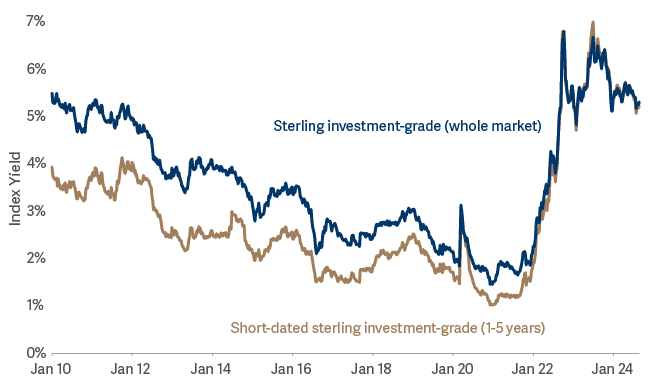Lower risk, high reward: A simple case for short-dated, investment-grade bonds
At this point in the market cycle, investing in short-dated investment-grade bonds allows cautious investors to enjoy the inflation-beating yields of an all-maturity bond fund but with far less interest-rate risk and significantly lower volatility.
An iron law of finance insists that there’s always trade-off between risk and reward. In my experience, however, the trade-off is far from perfect – and it varies over time.
Throughout my career, there have been windows of opportunity when it was possible to harvest healthy returns that were disproportionate to the risks I was taking. These windows don’t stay open forever. But, at this moment in time, I would strongly argue that, while the outlook for bonds of almost every variety is attractive, the outlook for short-dated, investment-grade bonds is compelling on a risk-adjusted basis. This should make them the first port of call for cautious investors seeking low-beta, cash-plus returns.
1. Low volatility
As interest rates move lower, it is natural that cautious investors may look to the bond market to secure a higher level of income. At the same time, they may be wary of exposing themselves to the volatility that comes with owning an all-maturity bond fund. By buying short-dated investment-grade bonds, investors can receive a healthy yield but with significantly lower volatility than they would experience in the wider bond market.
Since January 2010, annual volatility in three key areas of the UK bond market has been:
| Gilts | 8.01% |
| Sterling investment-grade (whole market) | 6.24% |
| Short-dated sterling investment-grade (1-5 years) | 2.53% |
To me, that suggests short-dated investment-grade bonds are a good place for investors preparing to take first tentative step on the risk ladder.
2. Low interest-rate risk
Short-dated bonds are less volatile largely because they are significantly less sensitive to fluctuations in long-term interest-rate expectations. In other words, they have less duration.
At the end of September, one common benchmark for short-dated corporate debt, the ICE BofA 1-3 Year Sterling Corporate & Collateralized Index, had a modified duration of 1.7 years. Its all-maturities bigger brother, the ICE BofA Sterling Corporate & Collateralized Index, had a modified duration of 5.8 years1.
So, by buying short-dated bonds, investors are exposing themselves to roughly a third of the interest-rate risk.
To be clear: we think interest rates are going down from here rather than up. And there’s a good chance they’re going to fall by more than the market is currently pricing in. So, we’re not averse to carrying interest-rate risk in some of our other funds at this point.
At the same time, the past three decades have shown me how difficult predicting interest rates is and how often the experts get it wrong. I fully accept that reasonable opinions on interest rates will differ and that adding interest-rate risk is not for everyone. For those worried that rates won’t fall as far as the market currently expects, short-dated investment grade bonds could be the sweet spot.
3. Attractive yields
Short-dated investment-grade bonds offer lower volatility and less interest-rate risk than the wider market. But what about the returns?
At this juncture, yields on short-dated corporate bonds are roughly similar to those on the wider investment-grade market. This is at a time when ‘real’ yields on investment-grade corporate bonds of all maturities are attractive.
Yields across the sterling investment-grade market are high

Our simple conclusion is that the risk/reward in the short-dated investment-grade bond market today is compelling. Investing here allows cautious investors to share in one of the most attractive features of corporate bonds – their inflation-beating yields – while exposing their portfolios to just a fraction of the risk that would come with owning an all-maturity bond fund.
To be clear, however, that hasn’t always the case. Back in March 2021, I wrote an article – Short-dated Bonds: Past Perfect? – in which I argued that short-dated investment grade bonds were very much not the place you wanted to be at that time; three-and-a-half years ago, yields in this part of the market were so low that bondholders had no cushion to protect them when capital values fell. Investors were assuming a lot of risk but receiving precious little reward.
The situation has changed entirely since then. Yields are attractive and offer a useful cushion should there be any decline in capital values. That’s one reason why around 58%2 of the Artemis Short-Duration Strategic Bond Fund is currently invested in this part of the market.
At the same time, I would argue that making an all-in, inflexible allocation to investment-grade bonds would be unwise; as returns from our short-duration fund have shown, there are other ways to generate returns without taking too much interest-rate risk, such as implementing relative value trades or curve trades in the government bond market or by adding selected exposure to carefully selected short-dated high-yield bonds.
Today, however, the tactical case for having a significant level of exposure to short-dated investment-grade bonds appears to be clear. Markets don’t always offer attractive returns in exchange for such a modest degree of risk. When they do, I suggest you take them up on that offer.
2Source: Artemis as at 31 October 2024

